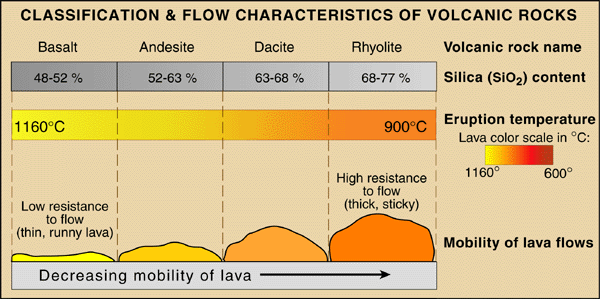
Illustration by J. Johnson from USGS web site: http://volcanoes.usgs.gov/about/pglossary/VolRocks.php
Definitions you should know:
Tsunami - A tsunami is a
very long-wavelength wave of water that is generated by sudden displacement
of the seafloor or disruption of any body of standing water
Angle of repose the steepest
angle that a slope can maintain without collapsing
Debris avalanche fast
moving, gravity-driven currents of partially or fully water-saturated debris
not confined to an established channel.
Debris flow when moving
debris is water-saturated and follows drainage channels.
Mudflow when most of the
debris is mud-sized.
Lahar a mudflow where
the debris is volcanic material, such as wet ash.
Ignimbrites - the material
deposited by pryoclastic flows (and are also called tuffs)
Caldera - a large depression
caused by collapse after rapid removal of magma from a magma chamber.
Usually, but not always, involves explosive eruption.
A resurgent caldera is a
depression containing an uplifted caldera floor (resurgent dome).
Tephra - generic term for
pyroclasic deposits - includes ash, lapilli/cinder, blocks and bombs
Other terms you should know include: hummocky terrain, pahoehoe and aa (two types of basaltic lava flows), block flows, domes, intracanyon flow, columnar joints (formed as shrinkage cracks and the cracks move away from the cooling surfaces), vesicles (and that they indicate the top of a lava flow), lava tubes, tumulus, lateral blast, pyroclastic flow, fire fountain, spatter cone, shield volcano, composite volcano (also known as stratovolcano), eruption column, cinder cone, the hydrovolcanic features known as maars (such as Hole in the Ground) and tuff rings (such as Diamond Head). You should have some idea of what some of these features look like.
Rocks: scoria, pumice, obsidian, breccia, tuff, reticulite
We discussed a lot of these features in terms of composition -- see chart below. Shield volcanoes indicate basaltic lavas; stratovolcanoes indicate primarily intermediate lavas (andesite and dacite) and subduction zones. Rhyolitic magmas tend to make really big calderas, but can also produce block flows and domes (when not explosive).

Illustration by J. Johnson from USGS web site:
http://volcanoes.usgs.gov/about/pglossary/VolRocks.php
The largest tsunamis are associated with volcanic eruptions or landslides, not with subduction zone earthquakes
Gases emitted by volcanoes
include water vapor, carbon dioxide, sulfur dioxide, nitrogren, and fluorine.
Trees at Long Valley caldera have been killed by carbon dioxide.